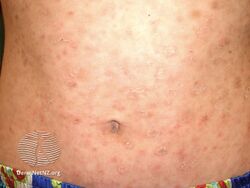Pityriasis lichenoides chronica
| Pityriasis lichenoides chronica | |
|---|---|
| Other names: Chronic guttate parapsoriasis, Chronic pityriasis lichenoides, Dermatitis psoriasiformis nodularis, Parapsoriasis chronica, Parapsoriasis lichenoides chronica | |
| Usual onset | It appears in crops. Erythematous scaly papules mixed with hyper or hypopigmented macules over trunk, limbs are seen. removal of scale reveals shiny brown surface underneath. |
| Duration | can be chronic. lasting over weeks to months. |
| Causes | Not known. previous bacterial or viral infection can be suspected. |
| Diagnostic method | Clinical and morphological evaluation can be difficult. Skin biopsy from a scaly papule can be diagnostic. |
Pityriasis lichenoides chronica (PLC) is an uncommon, idiopathic, acquired dermatosis, characterized by evolving groups of erythematous, scaly papules that may persist for months. [1]: 456 [2]: 737
Symptoms and signs
Although other forms of the disease occur at younger ages, some individuals start having long term symptoms at thirty years of age. This disease also affects adolescents and young adults. This also affects the immune system which therefore results in rashes. The symptoms rarely affect the face or scalp, but occurs at other sites of the body. The duration may last for months or even several years. For instance, new crops of lesions appear every few weeks.[3]
-
Pityriasis lichenoides chronica
-
Pityriasis lichenoides chronica
-
Pityriasis lichenoides chronica
-
Pityriasis lichenoides chronica
Causes
Pityriasis lichenoides chronica is probably caused by a hypersensitivity reaction to infectious agents such as the Epstein–Barr virus. Other infectious agents include the adenovirus and Parvovirus B19.[4]
Diagnosis
This section is empty. You can help by adding to it. (June 2017) |
Treatment
There is no standard treatment for PLC. Treatments may include ultraviolet phototherapy, topical steroids, sun exposure, oral antibiotics, corticosteroid creams and ointments to treat rash and itching.[3][5]One study identified the enzyme bromelain as an effective therapeutic option for PLC.[6]
See also
References
- ↑ Freedberg, et al. (2003). Fitzpatrick's Dermatology in General Medicine. (6th ed.). McGraw-Hill. ISBN 0-07-138076-0.
- ↑ James, William D.; Berger, Timothy G.; et al. (2006). Andrews' Diseases of the Skin: clinical Dermatology. Saunders Elsevier. ISBN 0-7216-2921-0.
- ↑ 3.0 3.1 https://web.archive.org/web/20101115054743/http://www.articleclick.com/Article/Pityriasis-Lichenoides-Chronica-Treatment-Tips/955864. Archived from the original on 2010-11-15.
{{cite web}}: Missing or empty|title=(help) - ↑ Jeffrey S Henning DO (2004). "Pityriasis lichenoides chronica". Dermatology.cdlib.org. 10 (3). Archived from the original on 2012-10-03. Retrieved 2020-12-16.
- ↑ Henning, Jeffrey S. (2004). "Pityriasis lichenoides chronica [eScholarship]". Dermatology Online Journal. 10 (3). Archived from the original on 2012-10-03. Retrieved 2020-12-16.
- ↑ "Role of bromelain in the treatment of patients with pityriasis lichenoides chronica". Archived from the original on 2021-08-28. Retrieved 2020-12-16.
External links
| Classification | |
|---|---|
| External resources |
- Pages with script errors
- CS1 errors: missing title
- CS1 errors: bare URL
- Articles to be expanded from June 2017
- Articles with invalid date parameter in template
- All articles to be expanded
- Articles with empty sections from June 2017
- All articles with empty sections
- Articles using small message boxes
- Immune system disorders
- Lymphoid-related cutaneous conditions



